Today you're going to learn how Laura Roeder and her team created a marketing funnel that powers a 7 figure SaaS company.
I was "introduced" to Laura years ago when she was promoting her online course and coaching business.
She leveraged OG internet marketing strategies to acquire coaching clients and customers for her courses.
Strategies like creating lead magnets, direct response copywriting, and email marketing sequences.
Laura and her team at Paperbell deployed those strategies to create the marketing funnel for her software company Paperbell, software to help coaches make more money and manage clients.
So, while I don't have all of Laura's numbers, here's what we know:
1. Paperbell is doing 7 figures. You can check out her interview with Noah Kagan where she talks about growing it.
2. She generated almost 32,000 leads last year from her marketing funnel. Daaaammmmmmnnnnnn!

In this post, we're going to break down her entire funnel.
You're going to see how Paperbell:
- Uses lead magnets to capture leads
- Creates a welcome email designed to get you to try Paperbell
- Builds an email sequence so that they remain at the customer's top of mind days and weeks AFTER they've downloaded the lead magnet.
What is a SaaS Marketing Funnel
A SaaS Marketing funnel is the marketing sequence that runs on autopilot that turns website visitors into paying customers.
For instance, visitors enter your site through SEO or PPC or Social Media, etc. Then the SaaS funnel captures leads and converts a percentage of them into users of your product.
Paperbell's SaaS Marketing Funnel
Remember what I said in the beginning of this post.
Paperbell deploys some OG internet marketing style funnels.
So at a high level, their funnel looks like this:
Step 1: They created a high converting lead magnet deployed on both blog popups and landing pages.
Step 2: She offers her product through her "Thank you page"
Step 3: She has a multi-week long email sequence designed to remind you to sign up for a free account of Paperbell.
Now we're going to dig into all 3 component's of Paperbell's million dollar SaaS marketing funnel.
You're going to see their lead magnets, sales pages, and emails.
So grab a glass of your favorite beverage and enjoy the post! 🙂
Step 1: A High Converting Lead Magnet
Most SaaS companies do it wrong.
They try to get people who are reading their blog to convert into paying users right away.
That can work. But they're leaving a lot of money on the table.
According to Chet Holmes, only 3% of the market is ready to buy your product today.
That means that at best, your website is going to convert 3% of visitors into paying customers. That's if you have optimized the site perfectly.
Paperbell decided to take a different approach.
Instead of optimizing for the 3%, they decided to optimize for the 97% of the visitors who aren't ready to buy your product right now.
(Don't worry, they still get the one's who do... more on that later).
Paperbell captures email addresses so they can remarket their leads down the road - dramatically increasing their reader to customer ratio.
Here's a screen grab of their lead magnet:

A few things to notice with this pop-up.
First of all, it's super simple. Just a hero image and a form with only 2 entries. They aren't asking for company name, phone numbers, etc. Just first name and last name.
Second, she is offering a solution to a problem that coaches face: How much should I charge my clients?
Finally, she has a testimonial - for the free give away. Social proof works in selling your SaaS. It also works in "selling" your free give aways.
Step 2: Redirect them to a Free Trial
Want to know what the most seen part of any marketing funnel is?
As any OG internet marketer like Laura will tell you: It's the Thank You Page.
Want to know what the most wasted real estate within a marketing funnel is? You guessed it: The Thank You Page.
Instead of wasting that real estate, the Paperbell team turned their thank you page into an opportunity to sell the software.
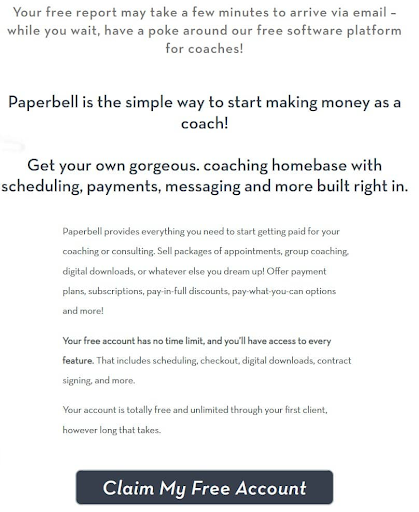
At the very top of the page she tells you that "yes, you're in the right spot, the free report is headed your way".
Now, let's get to the meat of the thank you page.
In psychology there's a thing called a Micro-Yes. It says that once you've said yes to a small commitment, you're more likely to say yes again to a slightly larger commitment.
For Paperbell, they asked their readers to say yes to a small commitment: give me your name and email address, and we'll send you a valuable free report.
Now, on the thank you page, they're keeping the momentum going and asking for a slightly larger commitment: Sign up for a free account - no credit card required.
In this page, Paperbell tells you the benefits of signing up. You get a 100% free account to manage your first client. You get to use all the features for an unlimited time.
Implied in this page, of course, is that once you love using Paperbell with one client, you're going to want to use it for the second client - which you'll be asked to pay for the product.
But this is a great opening to get people further into the Paperbell ecosystem. From email list subscriber, to actually trying out the product.
Step 3: An Automated Email Sequence
The automated email sequence is where the heavy lifting.
In their automated sequence, Paperbell accomplishes two primary objectives.
First, they remind you to grab your free report.
Second, they sell the software with a series of stories, feature descriptions, and case studies.
So let's take a look at a few of the emails they send.
Day 1: Welcome Email
This is the email that arrives a few minutes after you sign up for the free report on pricing.
With their email, Paperbell does a few things.
1. They deliver the lead magnet.
2. They "sell" the software again by tying the lead magnet to the software. "Check out Paperbell, make sure to grab your free account to launch your own instant-buy coaching packages."
This is just brilliant. You've just downloaded a lead magnet on coaching packages. Then they tell you the software will create the package for you.
3. This isn't a faceless software company. This email is coming from Laura, complete with picture in the signature. A nice little touch to put a face to the product and company you're going to buy from.
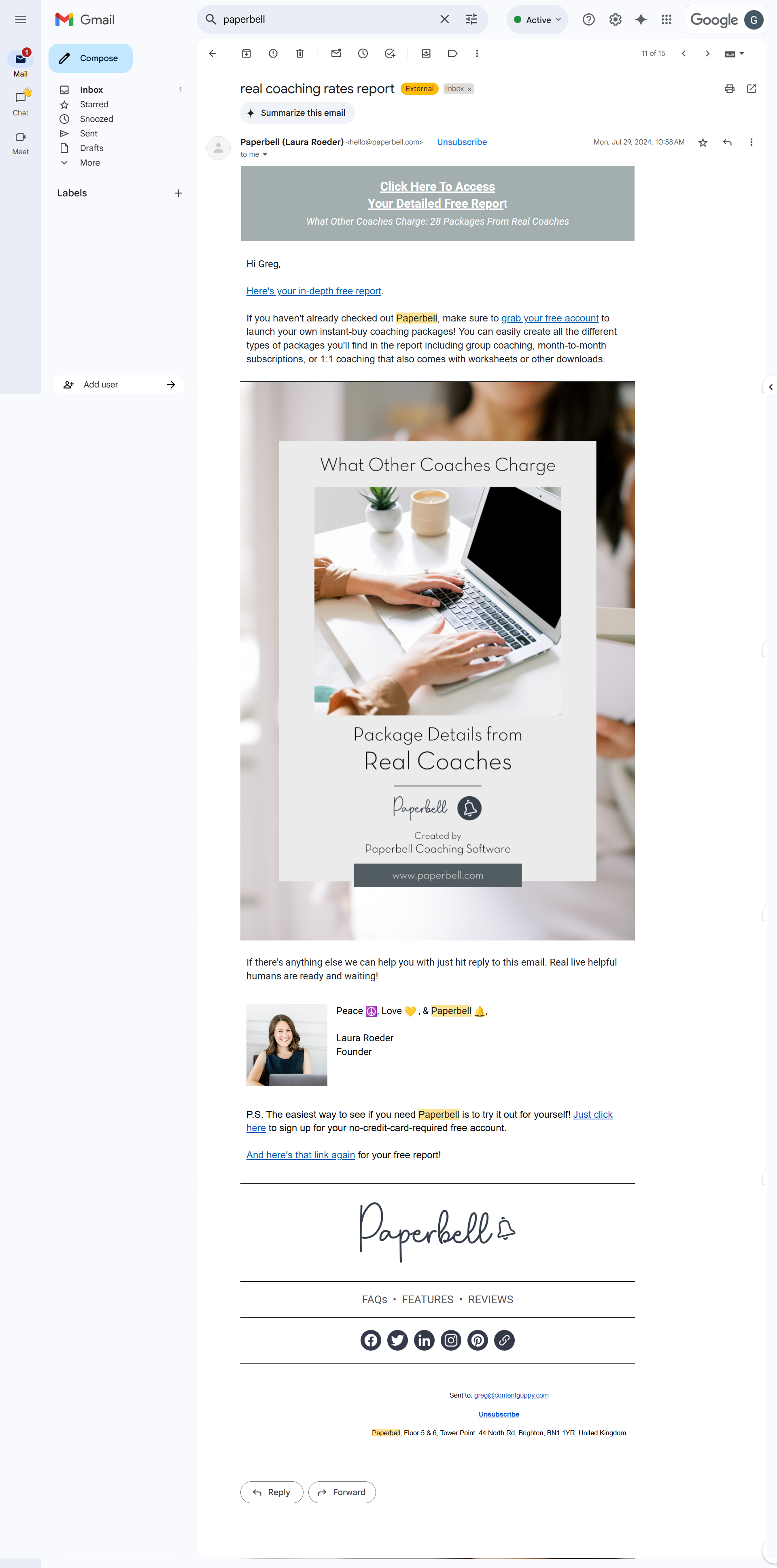
One more thing before we move on to the next email. Laura put a P.S. at the bottom of the email. Studies show that 90% of people will read the p.s. before they read any other part of the email.
Day 2: "Why do we exist?"
On day 2, Paperbell sends what I think is the most powerful email in their sequence.
I know it's long, but I encourage you to zoom in and read it.
Here's a few highlights:
1. Laura tells me why she started Paperbell. She believes "that you were not put on this earth to send out invoice reminders... Your calling isn't so much figures out who owes what, but instead has a little something to do with creating massive transformation for your clients."
That's super powerful. It's why Paperbell exists. So that coaches can do their life's calling - not waste time on admin.
2. She talks about what coaches were doing in the past (duct taping invoicing software, scheduling software, payment software together in order to run their business.
Then she goes on to tell you how Paperbell makes running a coaching business much easier by streamlining those solutions together for you.
3. She has testimonials. Social proof sells.
4. She has a simple call to action, again, asking you to sign up for a free Paperbell account (where, by the way, you don't need to enter your credit card to get started).

Yeah, I know it's a bit long. But seriously, zoom in and read it. It's brilliantly done.
Day 4: The Demo Email
This is a short email getting you to sign up for a demo of Paperbell.
This is a no-nonsense email.
But again, I really like how Paperbell uses Laura's image to put a face to the company you're going to use to run your coaching program.
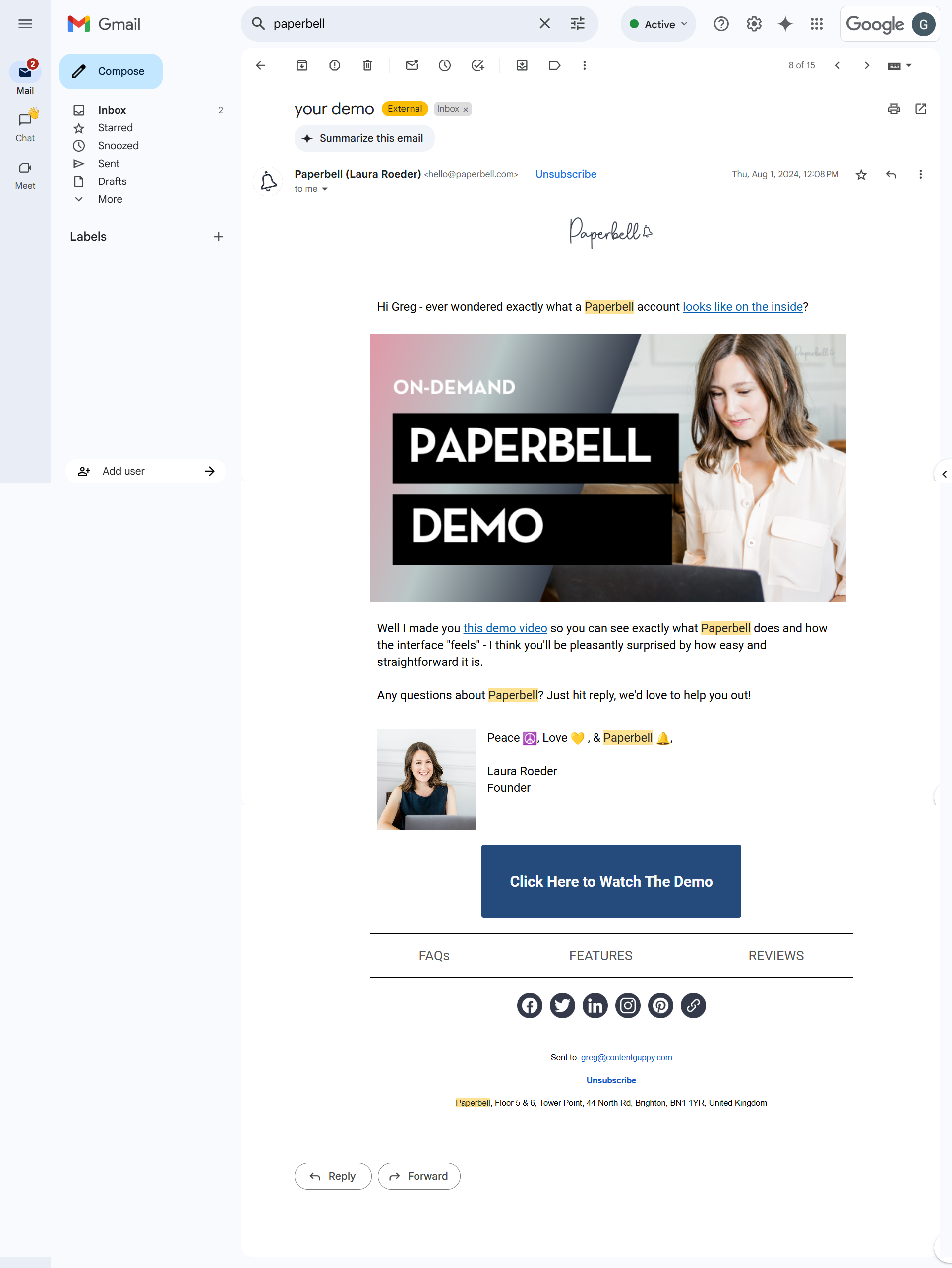
Day 7: "See it"?
On day 7, Paperbell just reminds you that they're offering you a free account with no credit card required.
Then they'll tell you how Paperbell makes your life better by streamlining a bunch of services together (invoicing, scehduling, onboarding, and more.)
A simple email just to get you to sign up for a free account.
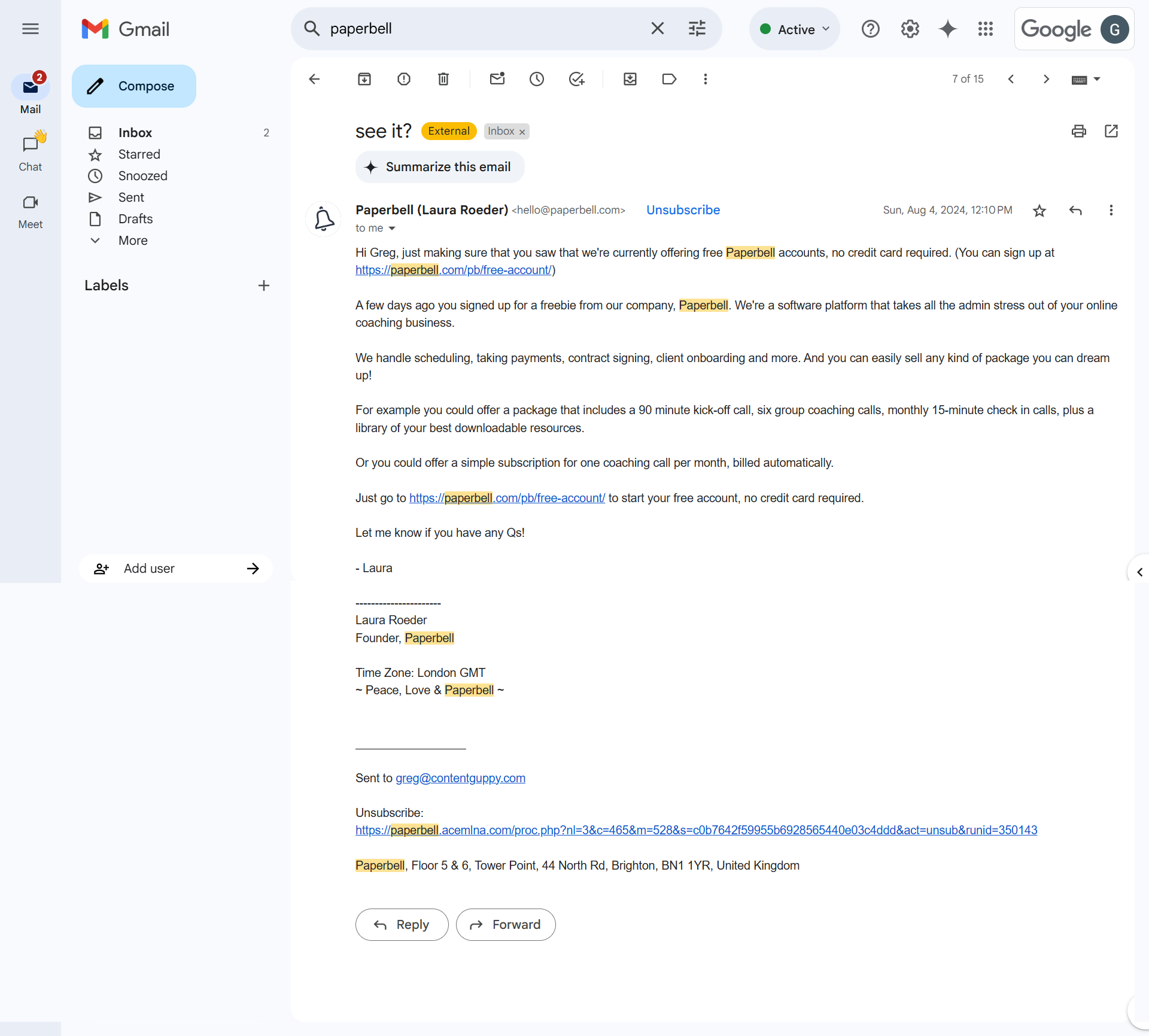
Day 11: Checking in
While Paperbell has a few more emails spaced out over the next couple of weeks, this is going to be the last one that we analyze.
This is the classic "checking in" email.
I noticed you didn't sign up for the free trial. Why not?
That kind of thing.
Marketers use this email as a way to get feedback from people who didn't sign up to see if the messaging was off, or if they were missing a use case, or if the product wasn't the right fit, etc.
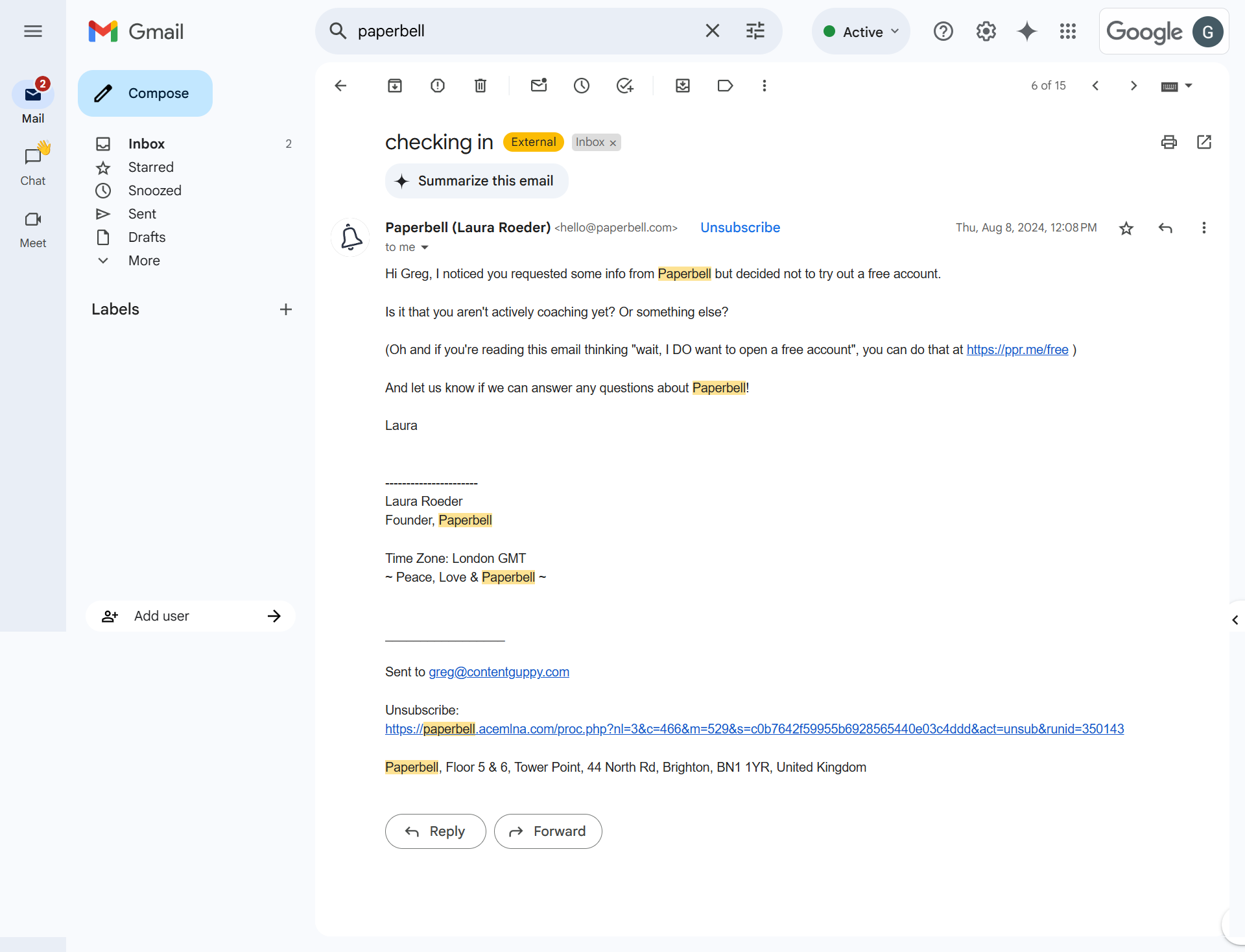
Tools to Build Your SaaS Marketing Funnel
A marketing funnel does not need to be complicated or expensive.
You're just going to need the following:
1. Popup Software: When someone comes to your blog, you're going to have a way to capture people's email addresses.
The Paperbell team uses OptinMonster - which is a popular WordPress popup tool.
2. Email Service Provider: Basically you're going to need a tool to send emails. This can be with something like Mailchimp, ActiveCampaign, or Userlist.
Over to You...
Now that you know all of the components of a SaaS Marketing Funnel, it's time to implement your own.
Take the email marketing sequence that Paperbell created and make it your own.

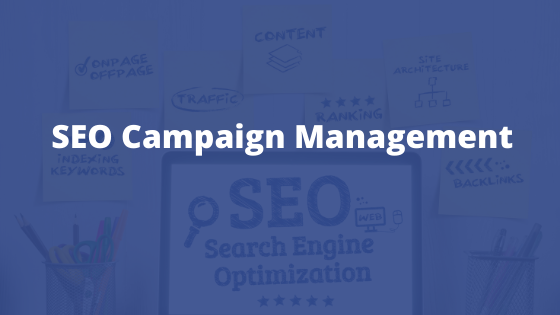
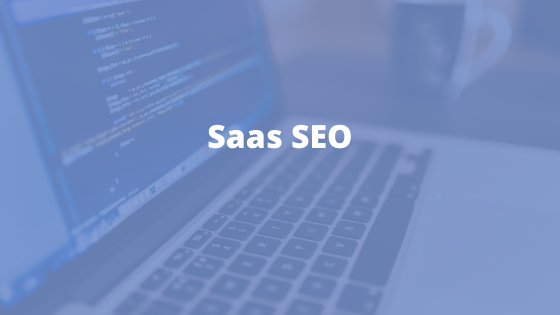
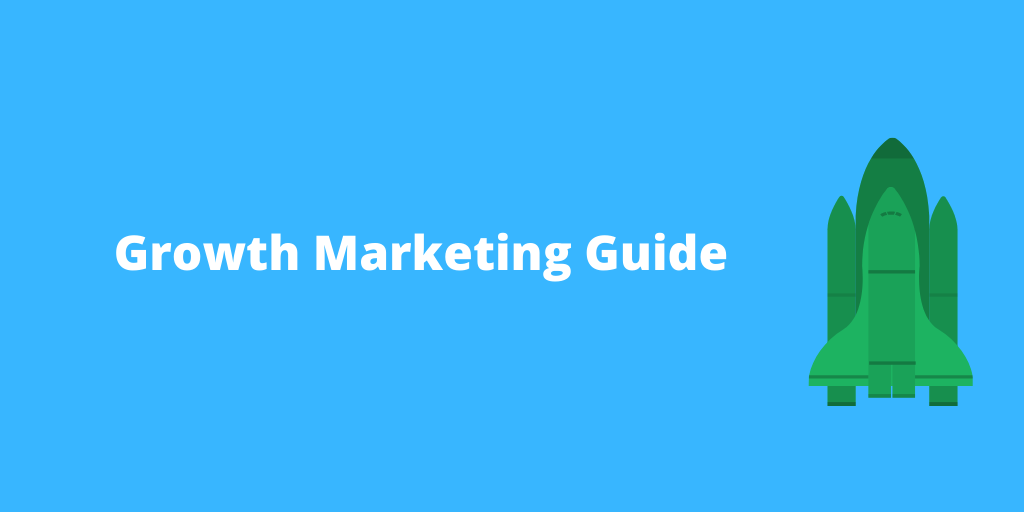
About The Author: Greg Digneo
I love helping people with their marketing. So I created this site to give you tools and information to help you grow your blog, build your audience, and get more sales.
More posts by Greg Digneo